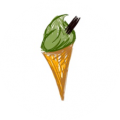This is a homage to the banana, the UK’s most coveted fruit!
The banana, contrary to popular belief, is not a fruit; it is in fact the world’s largest herb. The banana plant, or Musa sapientium, grow to six metres tall, but only produce a single inflorescence – one massive bunch of bananas – cutely named ‘the banana heart’. One of my favourite things about bananas is their lack of seasonality; they are harvested 365 days a year, and taste just as good January or June.
Globally we consume a whopping 10 billion bananas each year and in the UK, the Cavendish, our banana of choice, are supermarkets biggest selling item, kilo for kilo. Only the Germans eat more bananas than we do.A cheap treat, the health benefits of bananas are well known; tryptophan to make you happy, no fat, cholesterol or sodium, vitamin b for your skin and potassium to save that boy in Honey I Shrunk the Kids. Sucrose, glucose and fructose are a magical combination, with two bananas containing enough energy to see you through a strenuous 90-minute gym workout. The banana, in milkshake form boosted with honey, also makes for an excellent hangover cure.
The health and safety risks associated with the banana are less well documented. There are approximately 300 banana related accidents a year in Britain, needless to say that most of these involve people slipping on skins, Mario Kart style!
However, there is another, more pressing, cause for concern. Our beloved bananas are in danger of extinction! The Cavendish lacks genetic diversity, which prevents a build-up of disease resistance, and making it highly vulnerable to diseases. In particular, scientists are concerned that a fungus, the Panama disease, could wipe out the Cavendish in ten to twenty years. A strain of the Panama disease, TR4 has already been reaped havoc in South East Asia, wiping out the species from several countries. Although the disease is yet to reach the Americas, our concern is very real!
While much is being done in the realms of research to save the banana from extinction, I have myself been conducting some research on these pulpy fleshy delights. My (tested) theory is that by peeling bananas the wrong way, you get an all together more pleasurable experience. And, by the way, when I say the wrong way, its not really the wrong way, it’s the way monkeys do it.
So here is the technique, take the non-stem end, pinch it, creating a small tear and just go from there. What I have found is that by opening bananas this way, you are far less likely to encounter those stringy things coming off with your fruit. Those stingy things, which if my GCSE biology does not fail me, I believe are the xylem and phloem, and a mild annoyance for the banana enjoyer.
This alternative peeling method, allows the xylem and phloem to better stick to the banana, reducing the time taken to prepare your banana for eating. What’s also great about this method is that you will never have to use your nails or teeth to get to the fruit, and a handy ergonomic handle is created.
It should be noted that my theory has come under some criticism from my peers, and some more scientific testing would definitely be recommended. Nonetheless, in my experience, the conclusion is overwhelming- peeling the wrong way, is the right way forward.
With this revelation in mind, I hope you’re able to better enjoy your bananas from now on. And remember that we must continue to work hard to ensure the survival of our favourite fruit, so that it may be enjoyed by generations to come. Long live the Musa acuminate!
